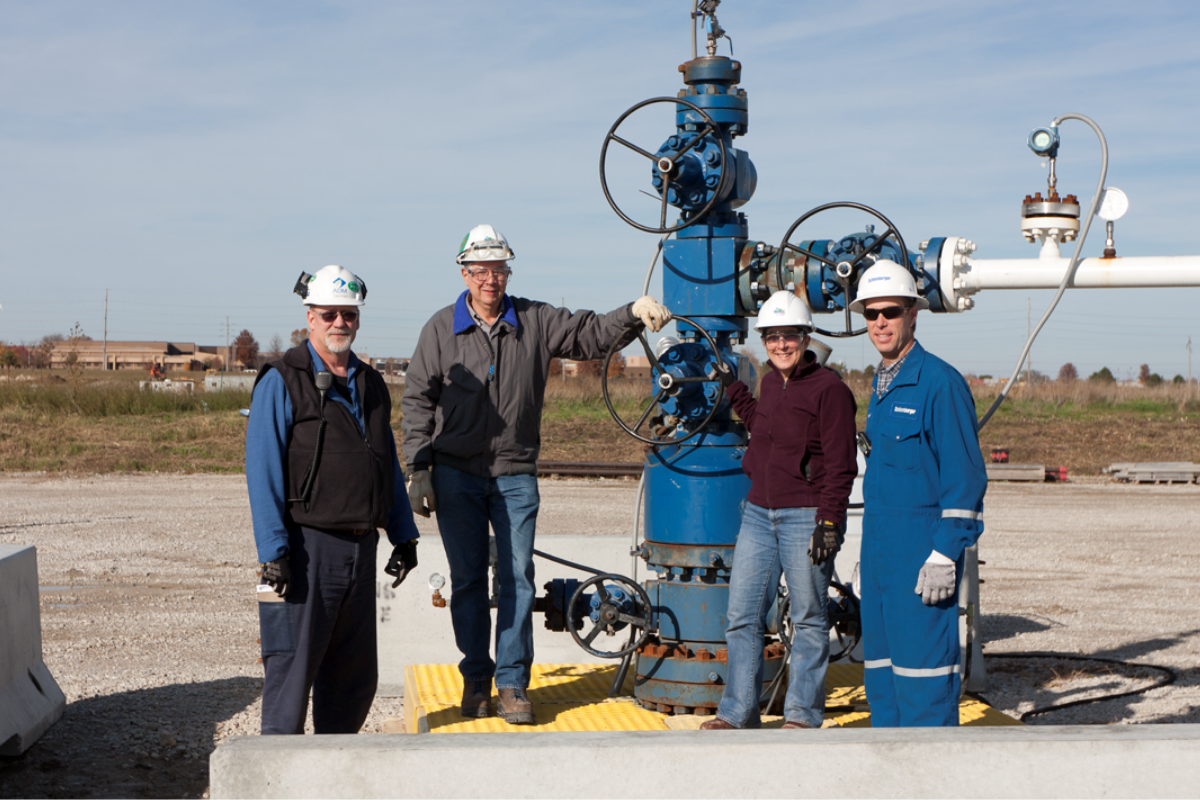
by Tricia Barker, Prairie Research Institute
The first-of-its-kind Illinois Basin – Decatur Project (IBDP), which concluded in 2021 after successfully demonstrating the safe geologic storage of carbon dioxide (CO2) at an almost-commercial scale, is releasing datasets in two easily accessible locations.
Complete datasets are available through the U.S. Department of Energy’s EDX site. Curated datasets are also being released through CO2DataShare, an international open-access portal managed by SINTEF.
Over three years, approximately 1 million metric tons of CO2 captured from the Archer Daniels Midland (ADM) ethanol production facility in Decatur, Illinois, were injected into the Mount Simon Sandstone, more than 2 km deep in the Illinois Basin. This carbon capture and storage (CCS) research and development project was carried out by the Midwest Geological Sequestration Consortium (MGSC), one of seven Regional Carbon Sequestration Partnerships funded by the U.S. Department of Energy (DOE) – National Energy Technology Laboratory to evaluate the safety and effectiveness of CO2 geological storage as a mitigation tool to address global climate change. The Illinois State Geological Survey (ISGS) at the University of Illinois was the principal investigator for and manager of the IBDP, with the Indiana Geological Survey (now the Indiana Geological and Water Survey) and the Kentucky Geological Survey as key partners. Other partners included ADM, Trimeric Corporation, and Schlumberger.
The infrastructure installed for the IBDP includes three deep wells: injection, monitoring, and geophysical. It also includes 17 shallow groundwater monitoring wells, microseismic monitoring with down-hole, four-component sensors in the injection well, an in-well geophysical monitoring array for repeat plume monitoring using vertical seismic profiling, a compression/dehydration facility, and a 1.9 km pipeline. The available data include information from pre-injection site characterization (2007-2011), injection and monitoring (2011-2014), and post-injection (2014-2021).
“The ISGS continues its exceptional service to DOE and the swelling number of CCS stakeholders here and abroad by sharing the rich data products generated from the Illinois Basin – Decatur Project,” said Darin Damiani, Carbon Transport and Storage Senior Program Manager for the DOE Office of Fossil Energy and Carbon Management. “DOE believes sharing high-value data from projects like the IBDP will help catalyze the growth and safe deployment of CCS in the U.S., as well as in nations looking to CCS as a component of their decarbonization strategy.”
The IBDP developed and implemented a rigorous monitoring, verification, and accounting (MVA) program for the captured and stored CO2. The extensive MVA activities include high-fidelity induced seismicity monitoring, 3D seismic surveying, 3D vertical seismic profiling, soil flux monitoring, atmospheric monitoring, shallow groundwater monitoring, and deep subsurface fluid sampling to ensure the CO2 remains safely stored underground.
“The Illinois Basin – Decatur Project led the way in developing and field-testing the full CCS value chain with carbon dioxide from biofuels production. We are proud to have created a project that has produced so much valuable data to share with colleagues and projects around the world,” said project principal investigator Sallie Greenberg.
Researchers interested in full the continuous microseismic dataset (not housed on EDX) should contact DOE NETL at EDXSupport@netl.doe.gov for more information.
An international collaboration between the United States and Norway has also been created to share selected datasets from the project on the CO2DataShare open access portal, including:
- GIS and georeferenced Imagery: provides a GIS-based portrayal and spatial archive of the IBDP project wells and the distribution of near-surface monitoring and sampling installations that were present at the IBDP field site.
- Seismic data: includes IBDP 3D seismic (volume reprocessed), IMDP 3D time-lapse VSP (vertical seismic profile) (reprocessed), and IBDP passive seismic events monitoring (microseismic).
- Well information: includes data collected from the project’s three deep wells, such as geophysical logs, core and sidewall core analyses, and various well tests. It also includes stratigraphic tops picked from the project wells and representative geologic cross-sections, as well as well design summary sheets and directional surveys.
- Horizons and faults: exported from the Petrel geological model.
- IBDP geological model: features a Petrel model containing wells, horizons, and fault interpretations from the project.
- Technical reports and final project report: includes geo-mechanical reports, site map images, static model reports, stratigraphy, well completion reports, well diagrams, well testing reports and the final report (Sallie E. Greenberg, Ph.D: ILLINOIS BASIN—DECATUR PROJECT Final Report: An Assessment of Geologic Carbon Sequestration Options in the Illinois Basin: Phase III. Illinois State Geological Survey. July 2021.). Other selected reports and outreach materials also are available.
CO₂ DataShare, a platform for sharing CO₂ storage data, was launched in 2020. The portal builds on UNINETT Sigma2’s solution for data storage, combined with a tailored frontend that was developed using the open-source software CKAN.
“We are excited to be able to share the unique data from the Illinois Basin – Decatur Project with the CCS communities around the world,” said CO2DataShare project manager Grethe Tangen. “The dataset complements the published data from Norwegian CO2 storage projects. In particular, the microseismic data represents a valuable addition to the CO2 DataShare dataset portfolio.”
Information about CO2DataShare can be found on its project webpage.
